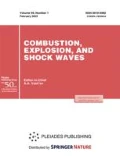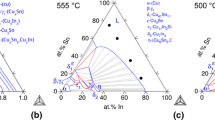Abstract
The explosive and physicochemical properties of porous mixtures based on ammonium nitrate, carbamide, and aluminum powder are considered. A melting curve for the ammonium nitrate/carbamide system is plotted using differential scanning calorimetry. The critical detonation diameter is obtained for a charge density of 0.6–0.7 g/cm3. The dependence of the charge density on the degree of filling of the mold with the melt is determined. Detonation velocity is measured for various densities. An explanation of the difference between the experimental and calculated values is proposed.
Similar content being viewed by others
References
B. N. Kondrikov, G. D. Kozak, and A. V. Starshinov, “Critical conditions of low and high velocity regimes in liquid nitrocompounds,” in: APPer Summaries 11th Int. Detonation Symposium, Snowmass (1998), pp. 231–234.
G. D. Kozak, B. N. Kondrikov, and A. I. Sumin, “Dependence of detonation velocity on charge density for foamed alumotol (Al/TNT) and TNT mixtures,” Combust., Expl., Shock Waves, 34, No. 4, 448–452 (1998).
V. M. Olevskii (ed.), Production of Ammonium Nitrate in High-Output Aggregates [in Russian], Khimiya, Moscow (1990).
A. I. Sumin, V. N. Gamezo, B. N. Kondrikov, V. M. Raikova, “Shock and detonation general kinetics and thermodynamics in reactive systems computer package,” in: Trans. of the 11th Int. Detonation Symp., Ampersand (2000), pp. 30–35.
B. N. Kondrikov, V. É. Annikov, and G. D. Kozak, “A generalized dependence of the critical detonation diameter of porous substances on the density,” Combust., Expl., Shock Waves, 33, No. 2, 219–339 (1997).
G. D. Kozak, V. M. Raikova, and E. I. Aleshkina, Critical Conditions of Propagation and Photorecording of Detonation Processes [in Russian], Mendeleev Russian Chem.-Technol. Univ., Moscow (2005).
B. N. Kondrikov and V. M. Raikov, “Detonation limits of explosive solutions,” Combust., Expl., Shock Waves, 13, No. 1, 46–51 (1977).
E. A. Likholatov, “Calculation of the kinetic characteristics of chemical transformation of organic liquids in a detonation wave,” Candidate Dissertation in Tech. Sci., Moscow (2004).
V. E. Annikov, B. N. Kondrikov, N. I. Akinin, and G. D. Kozak, Properties and Safety of Water-Filled Explosive Systems [in Russian], Mendeleev Russian Chem.-Technol. Univ., Moscow (2006).
V. E. Annikov, B. N. Kondrikov, N. I. Akinin, and G. D. Kozak, “Detonation aluminum-containing water-filled explosives,” in: Issues of the Theory of Explosives, Proc. Mendeleev Moscow Chemical-Technological Institute, No. 83 (1974), pp. 79–88.
Author information
Authors and Affiliations
Corresponding author
Additional information
__________
Translated from Fizika Goreniya i Vzryva, Vol. 46, No. 1, pp. 80–84, January–February, 2010.
Rights and permissions
About this article
Cite this article
Kozak, G.D., Starshinov, A.V., Litovka, O.B. et al. Properties of porous cast charges based on mixtures of ammonium nitrate and carbamide. Combust Explos Shock Waves 46, 70–73 (2010). https://doi.org/10.1007/s10573-010-0012-x
Received:
Accepted:
Published:
Issue Date:
DOI: https://doi.org/10.1007/s10573-010-0012-x




